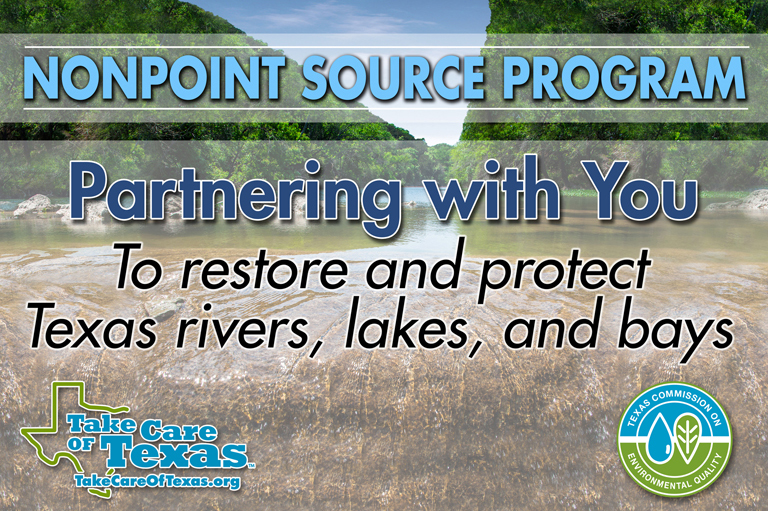Watershed Protection Plans for Nonpoint Source Water Pollution
What watershed protection plans are, how they are developed, and a list of all plans sponsored by TCEQ.

What is a Watershed Protection Plan?
Watershed Protection Plans (WPPs) are community-developed documents that identify potential sources of water body impairment throughout a watershed and provide a framework for implementation strategies to reduce pollution and improve overall water quality in Texas streams and rivers. TCEQ and the Texas State Soil and Water Conservation Board (TSSWCB) support the development and implementation of WPPs that prevent or manage nonpoint source pollution, and in most cases provide funding and technical assistance. A significant portion of Texas’ federal funding for managing nonpoint source pollution is dedicated to the development and implementation of WPPs and TMDL Implementation Plans.
Developing Watershed Protection Plans
All WPPs funded with Clean Water Act Section 319(h) grant funds are required to meet the U.S. Environmental Protection Agency's (EPA) Nine Elements for Watershed-based Plans (WBPs). Before committing to the development of a WPP it is important to ensure sufficient data are available to characterize pollutant sources. Preferably, this determination is made before applying for 319(h) funding. After this preliminary analysis, the TCEQ NPS Program recommends following these major steps:
- Watershed Characterization – Monitoring if additional data collection is necessary
- WPP Development
The approach taken to develop a WPP should be informed by stakeholder input. Development of a WPP generally takes about three years, depending on the nature of the work required. Multiple steps may be combined into one funding application, and streamlined projects are preferred. TCEQ funding of one step does not obligate the agency to fund additional steps of WPP development for that watershed.
Additional guidance is available on the EPA Clean Water Act Section 319 Web page and in EPA's Handbook for Developing Watershed Plans to Restore and Protect Our Waters .
Interactive Map and List of Watershed Protection Plans
Learn more about Texas WPPs using this interactive map that has links to partner webpages, pictures of best management practices, and much more. Visualize watershed characteristics such as land cover, stream impairments, and wastewater outfalls to evaluate WPP development potential.
TCEQ Sponsored WPPs that have been accepted by EPA
Year of EPA acceptance is provided in parentheses, and the links will take you to related NPS WPP Development Project webpages. If you would like a copy of any listed WPP please send an email to nps@tceq.texas.gov.
| Arroyo Colorado (2017) | La Nana Bayou (2023) |
| Bastrop Bayou (2016) | Lake Granbury (2011) |
| Big Elm Creek (2021) | Lavaca River (2018) |
| Brady Creek (2016) | Mission and Aransas Rivers (2021) |
| Caranchahua Bay (2019) | Nolan Creek (2019) |
| Colorado River below E.V. Spence (2013) | San Bernard River (2017) |
| Clear Creek (2024) | Shoal Creek (2021) |
| Cypress Creek - Segment 1009 (2021) | Spring Creek (2023) |
| Cypress Creek - Segment 1815 (2015) | Tres Palacios Creek (2018) |
| Dry Comal and Comal River (2018) | Upper Cibolo Creek (2013) |
| East Fork of the San Jacinto River (2024) | Upper San Antonio River (2015) |
| Hickory Creek (2016) | Upper San Marcos River (2018) |
| Highland Bayou (2021) | Village Creek and Lake Arlington (2019) |
| Joe Pool Lake (2022) | West Fork of the San Jacinto River and Lake Creek (2019) |
TCEQ Sponsored WPPs that are currently in development
| Arenosa and Garcitas Creeks | Rowlett Creek |
| Brays & Sims Bayous | Thompsons Creek |
| Greens Bayou |
TCEQ Sponsored Watershed Characterizations that are currently in development
| Brushy Creek | Tehuacana Creek |
| Northern and Central Lower Rio Grande Valley | Town Creek |
| Sandy Creek |
For a list of WPPs sponsored by TSSWCB please visit their Watershed Protection Plan Program website.
For More Information
Contact the NPS Program by email at nps@tceq.texas.gov, or call 512-239-6682.

 Back to top
Back to top